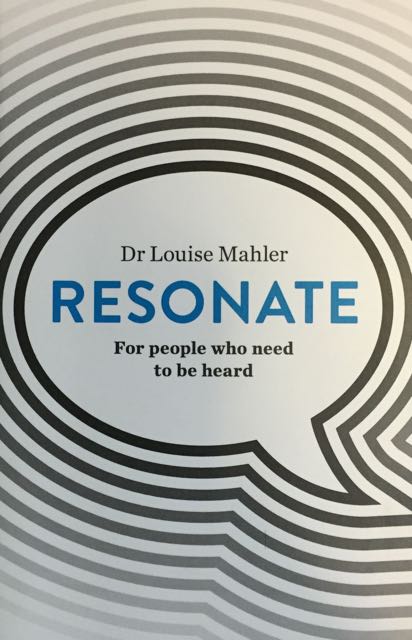Book 3/24 – Resonate
This book jumped out at me in the bookshop because of its eye-catching cover and the subtitle “For people who need to be heard”.

I’ve struggled to be heard for most of my life, and lived under the label of “softly spoken”, taking after my father. I hate increasing my volume because it feels like I’m shouting, it strains my voice and I feel very uncomfortable. I’m sure there are a number of reasons for this, including being introverted by nature, but I know that introverts can speak persuasively and authentically, so there’s no reason why I can’t improve my vocal technique and start to feel more confident as a communicator.
I’ve done a lot of public speaking and presentation courses, which are fine for what they are, but they never look at the actual technique of speaking and how different parts of your body work together to help you in communicating – or don’t work properly and make your communication less effective.
Enter Resonate by Dr Louise Mahler. Louise is a former opera singer, who moved into corporate training positions, where she used some of the techniques she’d learned as a performer to help her clients improve their communication skills. She came up with the term “vocal intelligence” to describe the process of “analysing your mind-body-voice cycle and getting it into sync so it’s running like a perfectly tuned Rolls Royce engine”.
Louise strongly believes that you are not stuck with the voice you have, and that there are things you can do to change it and to bring back your authentic voice. She says that we are all “born with a massive repertoire of sound and we squash it right down”. In the book she identifies seven veils, some or all of which we need to unfasten to let our true voice out.
Most of the book is about the seven veils and outlines work we can do to “unfasten” their grip on out voice. Diaphragm, posture, throat, mouth/tongue, eyes, movement and gestures.
The book is written in easy to understand language, with several case studies of people Louise has worked with and lots of exercises. It’s material about actual vocal techniques that I’d been searching for, as well as techniques to improve your presentation.
I read this book as part of one of my other projects for this year to improve my communication skills. (I know, this is not a SMART goal, but reading this book and doing all the exercises by 30 June according to a schedule that I’ve set out for myself is.) My plan is to work on each of the seven veils for two weeks, to learn the techniques and to practise them and gradually build them into the way I behave. I want to especially focus on the actual vocal techniques of the first four veils rather than the ones more related to presentation, as I think they’re the most significant barriers to my ability to communicate in the circumstances where I most have trouble, so I might decide to spend longer on some of them.
The very first thing I have to do is to do a short presentation in front of a trusted friend or family member to get some feedback on how I speak and how I present myself. That’s daunting enough to make me have delayed starting by several weeks. So much for the schedule.
I enjoyed reading this book and am looking forward to working through it in detail.
I am so glad you found this useful and do let me know if I can help further.
Projecting your voice does not have to strain your voice. You just have to know how!
Thank you Louise! I’m looking forward to working through the exercises.
Thank you Louise. I’m looking forward to learning how to do this. It’s getting more important now that my husband has developed a hearing loss at the frequency at which I speak, so he has trouble hearing me a lot of the time. I’ve recently reconnected with a yoga class and have been really interested to find that some of the things that you talk about in the books, like breathing and posture, have a lot in common with what I’m learning there. I love it when things align like that!
Regards Barb.
>